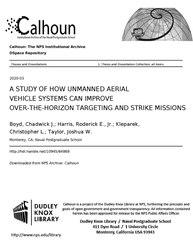File:A STUDY OF HOW UNMANNED AERIAL VEHICLE SYSTEMS CAN IMPROVE OVER-THE-HORIZON TARGETING AND STRIKE MISSIONS (IA astudyofhowunman1094564868).pdf

Original file (1,275 × 1,650 pixels, file size: 2.94 MB, MIME type: application/pdf, 90 pages)
Captions
Captions
Summary
[edit]| A STUDY OF HOW UNMANNED AERIAL VEHICLE SYSTEMS CAN IMPROVE OVER-THE-HORIZON TARGETING AND STRIKE MISSIONS
( |
||
|---|---|---|
| Author |
|
|
| Title |
A STUDY OF HOW UNMANNED AERIAL VEHICLE SYSTEMS CAN IMPROVE OVER-THE-HORIZON TARGETING AND STRIKE MISSIONS |
|
| Publisher |
Monterey, CA; Naval Postgraduate School |
|
| Description |
This capstone project studied the mission utility of using unmanned aerial vehicle (UAV) systems to accomplish the over-the-horizon mission by modeling a variety of UAV capabilities and evaluating their contribution. An Excel probabilistic model of the mission was created to determine the optimized weapon loadout and swarm configuration, which assumed the electronic countermeasures (ECM) UAV to have the highest probability of enemy engagement due to its lead formation position and large radar signature. An ExtendSim simulation added a time element to the study. Both the model and simulation revealed that a maximum air-to-air and strike weapon loadout, which is four weapons for each role, yields the highest probability of success at the lowest probability of a UAV casualty. A maximum air-to-air and strike loadout was found to produce success and UAV casualty probabilities of 98 and 3 percent, respectively. A comparative cost analysis assessed the financial viability of substituting UAVs for manned platforms. The analysis found the unit and per-flight hour cost, for all UAV platforms except those that fulfill the ECM role, to be less than the cost for manned counterparts. However, the use of the ECM UAV eliminates the potential for a flight crewmember casualty. Subjects: BREM; management; planning; game theory; unmanned; UAV; autonomous; decision matrix; configuration; loadout |
|
| Language | English | |
| Publication date | March 2020 | |
| Current location |
IA Collections: navalpostgraduateschoollibrary; fedlink |
|
| Accession number |
astudyofhowunman1094564868 |
|
| Source | ||
| Permission (Reusing this file) |
This publication is a work of the U.S. Government as defined in Title 17, United States Code, Section 101. Copyright protection is not available for this work in the United States. | |
Licensing
[edit]| Public domainPublic domainfalsefalse |
This work is in the public domain in the United States because it is a work prepared by an officer or employee of the United States Government as part of that person’s official duties under the terms of Title 17, Chapter 1, Section 105 of the US Code.
Note: This only applies to original works of the Federal Government and not to the work of any individual U.S. state, territory, commonwealth, county, municipality, or any other subdivision. This template also does not apply to postage stamp designs published by the United States Postal Service since 1978. (See § 313.6(C)(1) of Compendium of U.S. Copyright Office Practices). It also does not apply to certain US coins; see The US Mint Terms of Use.
|
 | |
| This file has been identified as being free of known restrictions under copyright law, including all related and neighboring rights. | ||
https://creativecommons.org/publicdomain/mark/1.0/PDMCreative Commons Public Domain Mark 1.0falsefalse
File history
Click on a date/time to view the file as it appeared at that time.
| Date/Time | Thumbnail | Dimensions | User | Comment | |
|---|---|---|---|---|---|
| current | 20:49, 14 July 2020 |  | 1,275 × 1,650, 90 pages (2.94 MB) | Fæ (talk | contribs) | FEDLINK - United States Federal Collection astudyofhowunman1094564868 (User talk:Fæ/IA books#Fork8) (batch 1993-2020 #8539) |
You cannot overwrite this file.
File usage on Commons
The following page uses this file:
Metadata
This file contains additional information such as Exif metadata which may have been added by the digital camera, scanner, or software program used to create or digitize it. If the file has been modified from its original state, some details such as the timestamp may not fully reflect those of the original file. The timestamp is only as accurate as the clock in the camera, and it may be completely wrong.
| Author | Aileen B. Houston |
|---|---|
| Short title | A STUDY OF HOW UNMANNED AERIAL VEHICLE SYSTEMS CAN IMPROVE OVER-THE-HORIZON TARGETING AND STRIKE MISSIONS |
| Image title | |
| File change date and time | 06:35, 15 April 2020 |
| Date and time of digitizing | 04:20, 13 March 2020 |
| Date metadata was last modified | 06:35, 15 April 2020 |
| Software used | Acrobat PDFMaker 17 for Word |
| Conversion program | Adobe PDF Library 15.0 |
| Encrypted | no |
| Page size |
|
| Version of PDF format | 1.4 |

